formerly eScholarship Editions


|
|
|
|
Your search for
'Medieval Studies' in subject
found 44 book(s). | Modify Search | Displaying 1 - 20 of 44 book(s) | |
| 1. | 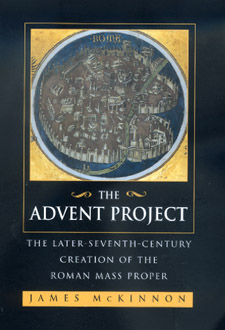 | Title: The Advent project: the later-seventh-century creation of the Roman Mass proper Author: McKinnon, James W 1932- Published: University of California Press, 2000 Subjects: Music | Musicology | Medieval Studies | Classical Religions | Christianity Publisher's Description: In his final accomplishment of an extraordinarily distinguished career, James W. McKinnon considers the musical practices of the early Church in this incisive examination of the history of Christian chant from the years a.d. 200 to 800. The result is an important book that is certain to have a long- . . . [more] Similar Items |
| 2. | 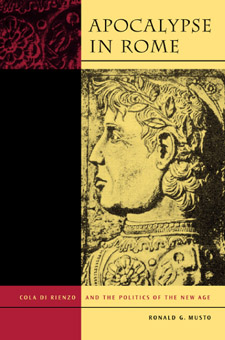 | Title: Apocalypse in Rome: Cola di Rienzo and the politics of the New Age Author: Musto, Ronald G Published: University of California Press, 2003 Subjects: History | European Studies | Medieval History | Medieval Studies | Autobiographies and Biographies | Classical Politics | Autobiographies and Biographies Publisher's Description: On May 20, 1347, Cola di Rienzo overthrew without violence the turbulent rule of Rome's barons and the absentee popes. A young visionary and the best political speaker of his time, Cola promised Rome a return to its former greatness. Ronald G. Musto's vivid biography of this charismatic leader - whose exploits have enlivened the work of poets, composers, and dramatists, as well as historians - peels away centuries of interpretation to reveal the realities of fourteenth-century Italy and to offer a comprehensive account of Cola's rise and fall. A man of modest origins, Cola gained a reputation as a talented professional with an unparalleled knowledge of Rome's classical remains. After earning the respect and friendship of Petrarch and the sponsorship of Pope Clement VI, Cola won the affections and loyalties of all classes of Romans. His buono stato established the reputation of Rome as the heralded New Jerusalem of the Apocalypse and quickly made the city a potent diplomatic and religious center that challenged the authority - and power - of both pope and emperor. At the height of Cola's rule, a conspiracy of pope and barons forced him to flee the city and live for years as a fugitive until he was betrayed and taken to Avignon to stand trial as a heretic. Musto relates the dramatic story of Cola's subsequent exoneration and return to central Italy as an agent of the new pope. But only weeks after he reestablished his government, he was slain by the Romans atop the Capitoline hill. In his exploration, Musto examines every known document pertaining to Cola's life, including papal, private, and diplomatic correspondence rarely used by earlier historians. With his intimate knowledge of historical Rome - its streets and ruins, its churches and palaces, from the busy Tiber riverfront to the lost splendor of the Capitoline - he brings a cinematic flair to this fascinating historical narrative. [brief] Similar Items |
| 3. | 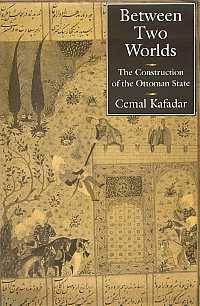 | Title: Between two worlds: the construction of the Ottoman state Author: Kafadar, Cemal 1954- Published: University of California Press, 1995 Subjects: History | Politics | Middle Eastern History | Middle Eastern Studies | Medieval History | Medieval Studies Publisher's Description: Cemal Kafadar offers a much more subtle and complex interpretation of the early Ottoman period than that provided by other historians. His careful analysis of medieval as well as modern historiography from the perspective of a cultural historian demonstrates how ethnic, tribal, linguistic, religious, and political affiliations were all at play in the struggle for power in Anatolia and the Balkans during the late Middle Ages.This highly original look at the rise of the Ottoman empire - the longest-lived political entity in human history - shows the transformation of a tiny frontier enterprise into a centralized imperial state that saw itself as both leader of the world's Muslims and heir to the Eastern Roman Empire. [brief] Similar Items |
| 4. | 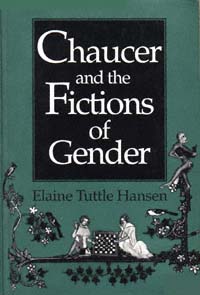 | Title: Chaucer and the fictions of gender Author: Hansen, Elaine Tuttle 1947- Published: University of California Press, 1992 Subjects: Literature | English Literature | Gender Studies | Medieval Studies Publisher's Description: Hansen challenges both the long-standing myth of Chaucer as the tolerant, wise Father of English poetry and the recent arguments that Chaucer was a protofeminist, subversive of the misogyny of his day. Hansen argues that these mistaken interpretations inhibit readings of Chaucer that respond to feminist and other poststructuralist critiques of traditional literary scholarship.Hansen suggests that the woman's voice in Chaucer reflects an urgent problem of gender identity for two kinds of men, both feminized by fourteenth-century courtly conventions: those who love women, and those who traffic in stories about women. She maintains that Chaucer destabilizes the notion of fixed gender difference but then privileges masculine identity by reconstructing the feminine in orthodox ways. Hansen exhorts readers of Chaucer, and students of the history of gender, to approach Chaucer's fictions with a more sophisticated awareness of their complexity and timeliness. [brief] Similar Items |
| 5. | 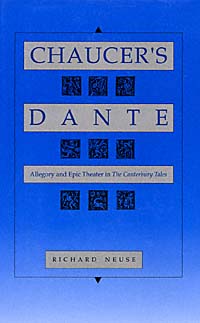 | Title: Chaucer's Dante: allegory and epic theater in The Canterbury tales Author: Neuse, Richard Published: University of California Press, 1991 Subjects: Literature | English Literature | European Literature | Medieval Studies Publisher's Description: Richard Neuse here explores the relationship between two great medieval epics, Dante's Divine Comedy and Chaucer's Canterbury Tales . He argues that Dante's attraction for Chaucer lay not so much in the spiritual dimension of the Divine Comedy as in the human.Borrowing Bertolt Brecht's phrase "epic theater," Neuse underscores the interest of both poets in presenting, as on a stage, flesh and blood characters in which readers would recognize the authors as well as themselves. As spiritual autobiography, both poems challenge the traditional medieval mode of allegory, with its tendency to separate body and soul, matter and spirit. Thus Neuse demonstrates that Chaucer and Dante embody a humanism not generally attributed to the fourteenth century. [brief] Similar Items |
| 6. | 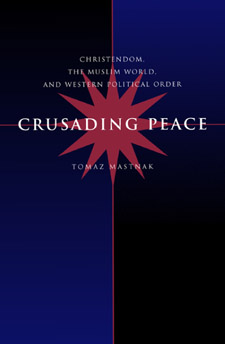 | Title: Crusading peace: Christendom, the Muslim world, and Western political order Author: Mastnak, Tomaž Published: University of California Press, 2002 Subjects: History | Medieval History | Middle Eastern History | Christianity | Medieval Studies | Middle Eastern Studies | Social Science | Political Theory Publisher's Description: Tomaz Mastnak's provocative analysis of the roots of peacemaking in the Western world elucidates struggles for peace that took place in the high and late Middle Ages. Mastnak traces the ways that eleventh-century peace movements, seeking to end violence among Christians, shaped not only power structures within Christendom but also the relationship of the Western Christian world to the world outside. The unification of Christian society under the banner of "holy peace" precipitated a fundamental division between the Christian and non-Christian worlds, and the postulated peace among Christians led to holy war against non-Christians. [brief] Similar Items |
| 7. | 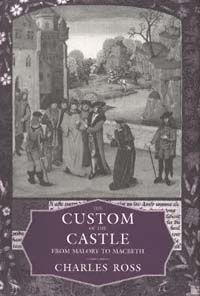 | Title: The custom of the castle: from Malory to Macbeth Author: Ross, Charles Stanley Published: University of California Press, 1997 Subjects: Literature | European History | English Literature | Medieval Studies | Renaissance Literature Publisher's Description: The "custom of the castle" imposes strange ordeals on knights and ladies seeking hospitality - daunting, mostly evil challenges that travelers must obey or even defend. This seemingly fantastic motif, first conceived by Chrètien de Troyes in the twelfth century and widely imitated in medieval French romance, flowered again when Italian and English authors adopted it during the century before Shakespeare's plays and the rise of the novel. Unlike other scholars who have dismissed it as pure literary convention, Charles Ross finds serious social purpose behind the custom of the castle.Ross explores the changing legal and cultural conceptions of custom in France, Italy, and England to uncover a broad array of moral issues in the many castle stories. He concentrates on single scenes that are common to a series of epics, showing how their nuanced narratives reflect real social limits of order, violence, justice, civility, and political conformity. His investigation of masterpieces from the thirteenth-century Lancelot to The Faerie Queene - by way of Malory, Boiardo, and Ariosto - demonstrates for the first time the impact on Shakespeare's plays, particularly Macbeth , of an earlier way of thinking about the strengths and weaknesses of social customs. [brief] Similar Items |
| 8. | 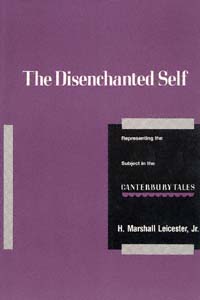 | Title: The disenchanted self: representing the subject in the Canterbury tales Author: Leicester, H. Marshall (Henry Marshall) 1942- Published: University of California Press, 1990 Subjects: Literature | Literary Theory and Criticism | Medieval Studies Publisher's Description: The question of the "dramatic principle" in the Canterbury Tales , of whether and how the individual tales relate to the pilgrims who are supposed to tell them, has long been a central issue in the interpretation of Chaucer's work. Drawing on ideas from deconstruction, psychoanalysis, and social theory, Leicester proposes that Chaucer can lead us beyond the impasses of contemporary literary theory and suggests new approaches to questions of agency, representation, and the gendered imagination.Leicester reads the Canterbury Tales as radically voiced and redefines concepts like "self" and "character" in the light of current discussions of language and subjectivity. He argues for Chaucer's disenchanted practical understanding of the constructed character of the self, gender, and society, building his case through close readings of the Pardoner's, Wife of Bath's, and Knight's tales. His study is among the first major treatments of Chaucer's poetry utilizing the techniques of contemporary literary theory and provides new models for reading the poems while revising many older views of them and of Chaucer's relation to his age. [brief] Similar Items |
| 9. | 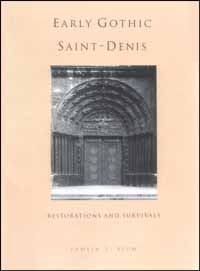 | Title: Early Gothic Saint-Denis: restorations and survivals Author: Blum, Pamela Z Published: University of California Press, 1992 Subjects: Art | Architectural History | Art History | Medieval Studies | Archaeology Publisher's Description: quality. Indeed, the well-preserved sculptural passages provide a key to the Early Gothic style as well as revealing the distinct imprints of three artists and their influences on each other. Blum's penetrating analyses of the restorative techniques and materials are accompanied by telling photograph-diagrams that distinguish the original work from that done later.Pamela Blum's investigation has relevance not only for students and scholars of medieval art but for curators and collectors as well. Anyone concerned with survivals from the past will appreciate her scrupulous detection in studying one of France's greatest monuments. [brief] Similar Items |
| 10. | 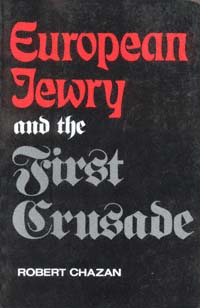 | Title: European Jewry and the First Crusade Author: Chazan, Robert Published: University of California Press, 1987 Subjects: Religion | Medieval History | Medieval Studies Publisher's Description: One of the unanticipated results of the First Crusade in 1095 was a series of violent assaults on major Jewish communities in the Rhineland. Robert Chazan offers the first detailed analysis of these events, illuminating the attitudes that triggered the assaults as well as the beliefs that informed J . . . [more] Similar Items |
| 11. | 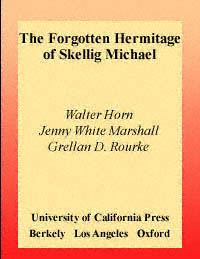 | Title: The forgotten hermitage of Skellig Michael Author: Horn, Walter William 1908- Published: University of California Press, 1990 Subjects: Architecture | Art | Architectural History | Medieval Studies Publisher's Description: This book is a dramatically told and visually stunning account of a ninth-century hermitage discovered on the South Peak of Skellig Michael, an island off the west coast of Ireland. It is the story, pieced together from fragmentary remains, study, and conjecture, of a man's attempt to live on a tiny ledge some 700 feet above the Atlantic on the outer edge of the European land mass, alone, as close to God as possible, in what is perhaps the ne plus ultra of ecstatic monastic solitude.Richly illustrated with maps, plans, and photographs that capture both the astonishing beauty and isolation of the hermitage, the text also includes reconstruction drawings of the site that combine a surveyor's accuracy with an artist's imaginative response to the hermit who found spiritual refuge on a pinnacle. [brief] Similar Items |
| 12. | 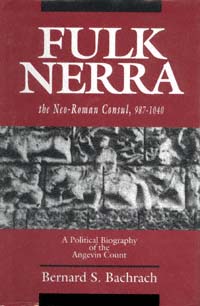 | Title: Fulk Nerra, the neo-Roman consul, 987-1040: a political biography of the Angevin count Author: Bachrach, Bernard S 1939- Published: University of California Press, 1993 Subjects: History | Medieval Studies | Medieval History Publisher's Description: This is the first comprehensive biography of Fulk Nerra, an important medieval ruler, who came to power in his teens and rose to be master in the west of the French Kingdom. Descendant of warriors and administrators who served the French kings, Fulk in turn built the state that provided a foundation for the vast Angevin empire later constructed by his descendants.Bernard Bachrach finds the terms "constructed" and "built" more than metaphorical in relation to Fulk's career. He shows how Fulk and the Angevin counts who followed him based their long-term state building policy on Roman strategies and fortifications described by Vegetius. This creative adaptation of Roman ideas and tactics, according to Bachrach, was the key to Fulk's successful consolidation of political power. Students of medieval and military history will find here a colorful, impressively researched biography. [brief] Similar Items |
| 13. | 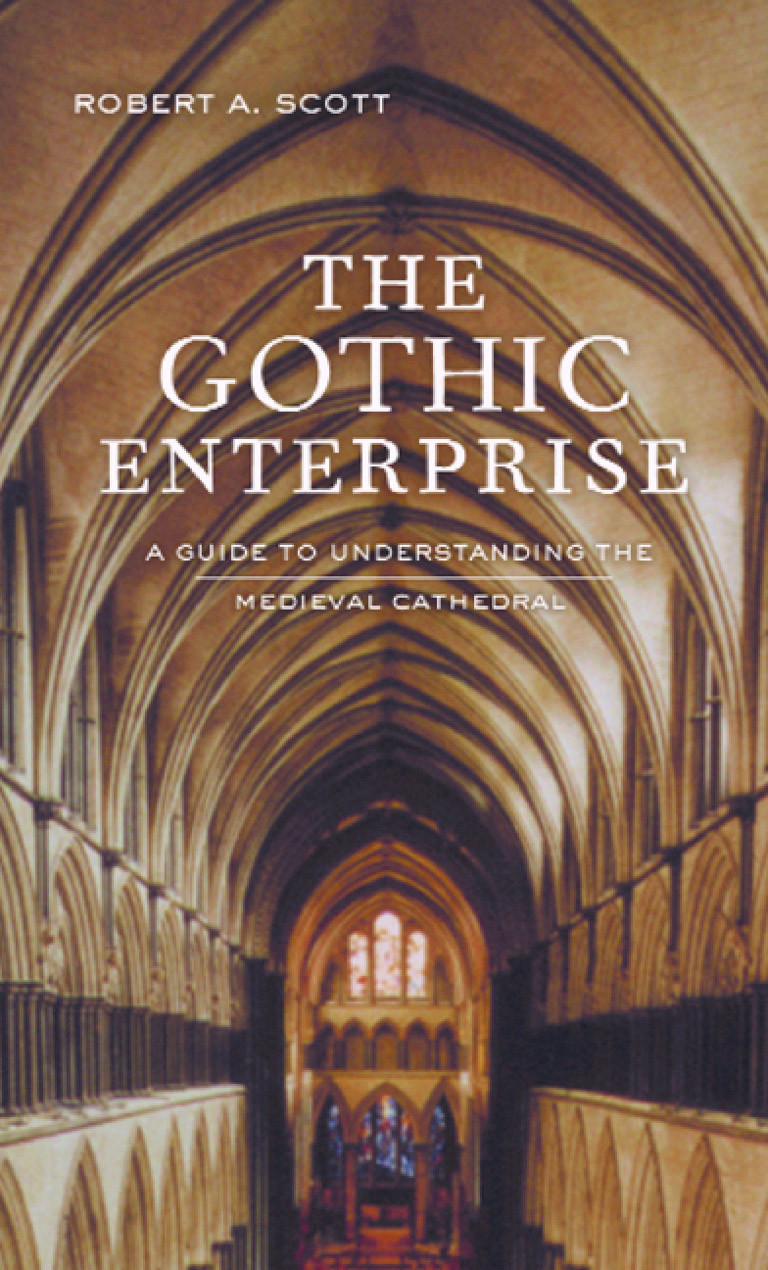 | Title: The Gothic enterprise: a guide to understanding the Medieval cathedral Author: Scott, Robert A 1935- Published: University of California Press, 2003 Subjects: Medieval Studies | Architecture | European Studies | Christianity | European History | Architectural History | Sociology | Sociology Publisher's Description: The great Gothic cathedrals of Europe are among the most astonishing achievements of Western culture. Evoking feelings of awe and humility, they make us want to understand what inspired the people who had the audacity to build them. This engrossing book surveys an era that has fired the historical imagination for centuries. In it Robert A. Scott explores why medieval people built Gothic cathedrals, how they built them, what conception of the divine lay behind their creation, and how religious and secular leaders used cathedrals for social and political purposes. As a traveler's companion or a rich source of knowledge for the armchair enthusiast, The Gothic Enterprise helps us understand how ordinary people managed such tremendous feats of physical and creative energy at a time when technology was rudimentary, famine and disease were rampant, the climate was often harsh, and communal life was unstable and incessantly violent. While most books about Gothic cathedrals focus on a particular building or on the cathedrals of a specific region, The Gothic Enterprise considers the idea of the cathedral as a humanly created space. Scott discusses why an impoverished people would commit so many social and personal resources to building something so physically stupendous and what this says about their ideas of the sacred, especially the vital role they ascribed to the divine as a protector against the dangers of everyday life. Scott's narrative offers a wealth of fascinating details concerning daily life during medieval times. The author describes the difficulties master-builders faced in scheduling construction that wouldn't be completed during their own lifetimes, how they managed without adequate numeric systems or paper on which to make detailed drawings, and how climate, natural disasters, wars, variations in the hours of daylight throughout the year, and the celebration of holy days affected the pace and timing of work. Scott also explains such things as the role of relics, the quarrying and transporting of stone, and the incessant conflict cathedral-building projects caused within their communities. Finally, by drawing comparisons between Gothic cathedrals and other monumental building projects, such as Stonehenge, Scott expands our understanding of the human impulses that shape our landscape. [brief] Similar Items |
| 14. |  | Title: History, religion, and antisemitism Author: Langmuir, Gavin I Published: University of California Press, 1990 Subjects: History | Medieval History | Judaism | Sociology | Medieval Studies | Middle Eastern History Publisher's Description: Gavin I. Langmuir's work on the formation and nature of antisemitism has earned him an international reputation. In History, Religion, and Antisemitism he bravely confronts the problems that arise when historians have to describe and explain religious phenomena, as any historian of antisemitism must. How, and to what extent, can the historian be objective? Is it possible to discuss Christian attitudes toward Jews, for example, without adopting the historical explanations of those whose thoughts and actions one is discussing? What, exactly, does the historian mean by "religion" or "religious"? Langmuir's original and stimulating responses to these questions reflect his inquiry into the approaches of anthropology, sociology, and psychology and into recent empirical research on the functioning of the mind and the nature of thought. His distinction between religiosity, a property of individuals, and religion, a social phenomenon, allows him to place unusual emphasis on the role of religious doubts and tensions and the irrationality they can produce. Defining antisemitism as irrational beliefs about Jews, he distinguishes Christian anti-Judaism from Christian antisemitism, demonstrates that antisemitism emerged in the twelfth and thirteenth centuries because of rising Christian doubts, and sketches how the revolutionary changes in religion and mentality in the modern period brought new faiths, new kinds of religious doubt, and a deadlier expression of antisemitism. Although he developed it in dealing with the difficult question of antisemitism, Langmuir's approach to religious history is important for historians in all areas. [brief] Similar Items |
| 15. | 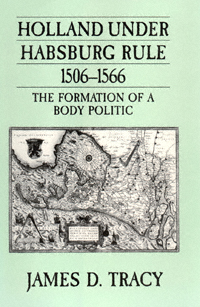 | Title: Holland under Habsburg rule, 1506-1566: the formation of a body politic Author: Tracy, James D Published: University of California Press, 1990 Subjects: History | European History | Politics | Medieval Studies Publisher's Description: Under what conditions were limited forms of self-government possible in medieval and early modern Europe? While many historians have sought an answer by focusing on the development of parliamentary institutions in emerging national monarchies, or investigating the wider autonomy enjoyed by various city-states within their own borders, James Tracy looks instead at an intermediate level of political organization, the self-governing province. Readers of medieval and early modern European history will learn here how the province of Holland, during the reigns of Charles V and Philip II (1506-1566), effectively underwent an apprenticeship in self-government. [brief] Similar Items |
| 16. | 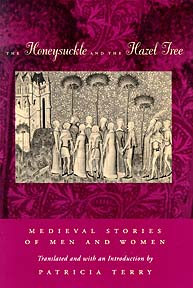 | Title: The honeysuckle and the hazel tree: medieval stories of men and women Author: Terry, Patricia Ann 1929- Published: University of California Press, 1995 Subjects: Literature | Literature in Translation | European Literature | Poetry | Literary Theory and Criticism | French Studies | Medieval Studies | Gender Studies Publisher's Description: Known for her fine translations of octosyllabic narrative verse, Patricia Terry presents translations of four major practitioners of this dominant literary form of twelfth- and thirteenth-century France. Her introduction discusses the varying views of women and love in the texts and their place in the courtly tradition.From Chrétien de Troyes Terry includes an early work, Philomena , here translated into verse for the first time. The other great writer of this period was Marie de France, the first woman in the European narrative tradition. Lanval is newly translated for this edition, which also features four of Marie's other poems. The collection further includes The Reflection by Jean Renart, known for his realistic settings; and the anonymous Chatelaine of Vergi , a fatalistic and perhaps more modern depiction of love. [brief] Similar Items |
| 17. | 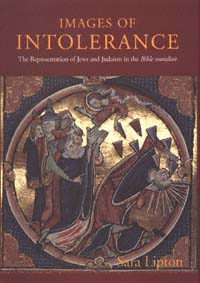 | Title: Images of intolerance: the representation of Jews and Judaism in the Bible moralisée Author: Lipton, Sara 1962- Published: University of California Press, 1999 Subjects: Jewish Studies | Medieval Studies | French Studies | Medieval History | Art History | Judaism Publisher's Description: Around the year 1225, an illuminated Bible was made for the king of France. That work and a companion volume, the two earliest surviving manuscripts of the Bible moralisée , are remarkable in a number of ways: they are massive in scope; they combine text and image to an unprecedented extent; and their illustrations, almost unique among medieval images in depicting contemporary figures and situations, comprise a vehement visual polemic against the Jews. In Images of Intolerance , Sara Lipton offers a nuanced and insightful reading of these extraordinary sources.Lipton investigates representations of Jews' economic activities, the depiction of Jews' scriptures in relation to Christian learning, the alleged association of Jews with heretics and other malefactors in Christian society, and their position in Christian eschatology. Jews are portrayed as threatening the purity of the Body of Christ, the integrity of the text of scripture, the faith, mores, and study habits of students, and the spiritual health of Christendom itself. Most interesting, however, is that the menacing themes in the Bible moralisée are represented in text and images as aspects of Jewish "perfidy" that are rampant among Christians as well. This innovative interdisciplinary study brings new understanding to the nature and development of social intolerance, and to the role art can play in that development. [brief] Similar Items |
| 18. | 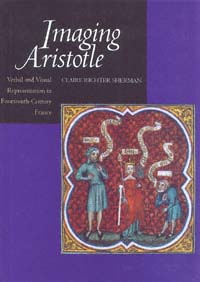 | Title: Imaging Aristotle: verbal and visual representation in fourteenth-century France Author: Sherman, Claire Richter Published: University of California Press, 1995 Subjects: Art | Art History | Medieval Studies Publisher's Description: Nicole Oresme's translation of Aristotle's Nicomachean Ethics, Politics, and Economics into French from Latin in the 1370s is the subject of Claire Sherman's stunningly illustrated book. Though both the text translations and their images have been studied separately, this is the first time they are published in their entirety and considered together.Intended for an audience of Charles V, his counselors, and high-ranking lay people, these manuscripts are significant for their linguistic and political implications, for moving Aristotle's work beyond clerical and university boundaries, and for reflecting the dynamics of monarchic control of French language and culture. Sherman shows the importance of Oresme's role as translator and book designer. She also explores the gender and class representations in the imagery, relating them not only to the views of Oresme and his audience but also to the contemporary secular culture. [brief] Similar Items |
| 19. | 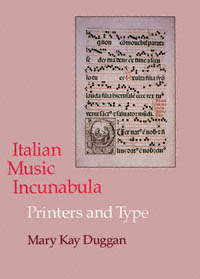 | Title: Italian music incunabula: printers and type Author: Duggan, Mary Kay Conyers Published: University of California Press, 1992 Subjects: Music | Musicology | Medieval Studies Publisher's Description: Musical notation presented unusual challenges to the new craft of printing in the fifteenth century. Its demands were so difficult that the first impression of music from metal type was not made until a full twenty years after the first printed alphabetic texts. By the end of the century dozens of such fonts had appeared throughout Europe. The books that resulted were often impressive volumes of folio or large-folio size, printed in two colors, with woodcut illustrations.Mary Kay Duggan focuses on the technological processes developed in Italy to print music books. She begins by tracing the history and analyzing the techniques of casting and setting type and staves. She then identifies, classifies, and examines thirty-eight specific types. Finally, the author has compiled a descriptive bibliography of Italian music incunabula, including books containing either printed music or blank spaces for the insertion of manuscript music. Italian Music Incunabula marks a major advance in the study of the paleotypography of music. It greatly enhances our understanding of the impact of the printing press on music and the importance of music books in the work of early printers. Its meticulous bibliography of over 150 incunabula, concordances, and indices will make it the standard reference work for many years to come. [brief] Similar Items |
| 20. | 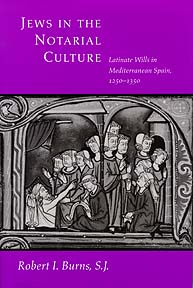 | Title: Jews in the notarial culture: Latinate wills in Mediterranean Spain, 1250-1350 Author: Burns, Robert Ignatius Published: University of California Press, 1996 Subjects: Medieval Studies | Judaism | Jewish Studies | European History | Law | Medieval History Publisher's Description: In the rapidly transforming world of thirteenth-century Mediterranean Spain, the all-purpose scribe and contract lawyer known as the notary became a familiar figure. Most legal transactions of the Roman Law Renaissance were framed in this functionary's notoriously hasty shorthand. Notarial archives, then, offer a remarkable window on the daily life of this pluri-ethnic society. Robert I. Burns brings together the testimony of a multitude of documents, and transcribes in full nearly fifty will-related charters prepared by notaries, to give a never-before-seen view of Jewish society in that place and time.Wills can display the religious conscience, ethical institutions, social mobility, and property dynamics of whole groups or regions. Even a single testament allows a glimpse into the testator's family and into the life and times of the living person. Burns devotes special attention to women in wills and to women's wills, extracting rich information on medieval women and gender relationships.While learning much about the role of kings and courts and the dynamics of Christian-Jewish relations, the reader also gains rare insights into a unique Jewish community. [brief] Similar Items |